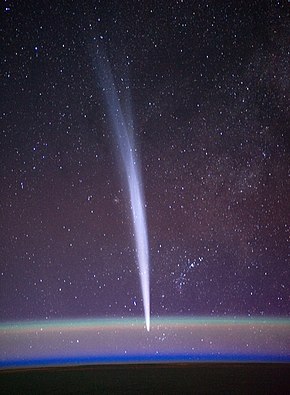 Comet Lovejoy photographed by Dan Burbank aboard the ISS, 21 December 2011 | |
| Discovery | |
|---|---|
| Discovered by | Terry Lovejoy |
| Discovery date | 27 November 2011 |
| Designations | |
| |
| Orbital characteristics[2] | |
| Epoch | JD 2455901.5 (6 December 2011) |
| Aphelion | 157.36±0.50 AU |
| Perihelion | 0.00555 AU |
| Semi-major axis | 78.68±0.25 AU |
| Eccentricity | 0.99993 |
| Orbital period | ~622 yr (epoch 2200)[1] |
| Max. orbital speed | 565 km/s |
| Inclination | 134.36°±0.002° |
| 326.369° | |
| Argument of periapsis | 53.5092° |
| Mean anomaly | 359.986° |
| Last perihelion | 16 December 2011 |
| Next perihelion | c. 2633?[1] |
Comet Lovejoy, formally designated C/2011 W3 (Lovejoy), is a long-period comet and Kreutz sungrazer. It was discovered in November 2011 by Australian amateur astronomer Terry Lovejoy. The comet's perihelion took it through the Sun's corona on 16 December 2011, after which it emerged intact, though greatly impacted by the event.[ambiguous]
As Comet Lovejoy was announced on the 16th anniversary of the SOHO satellite's launch it became known as "The Great Birthday Comet of 2011", and because it was visible from Earth during the Christmas holiday it was also nicknamed "The Great Christmas Comet of 2011".[3][4] Lovejoy was retroactively dubbed the Great Comet of 2011.[5]
- ^ a b Cite error: The named reference
horizonswas invoked but never defined (see the help page). - ^ "C/2011 W3 (Lovejoy)". Small-Body Database Lookup. ssd.jpl.nasa.gov. Retrieved 17 June 2024.
- ^ Cite error: The named reference
sungrazer-c1was invoked but never defined (see the help page). - ^ Cite error: The named reference
pcmag20111227was invoked but never defined (see the help page). - ^ "Great Comets: What Are They, And When Will the Next Comet Be Visible?". Star Walk. 16 October 2024. Retrieved 17 October 2024.